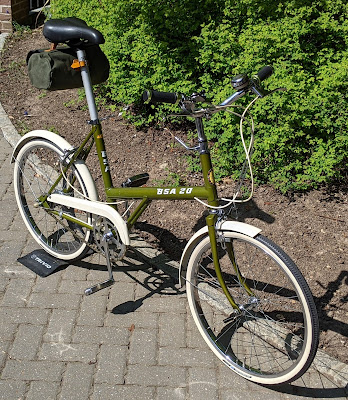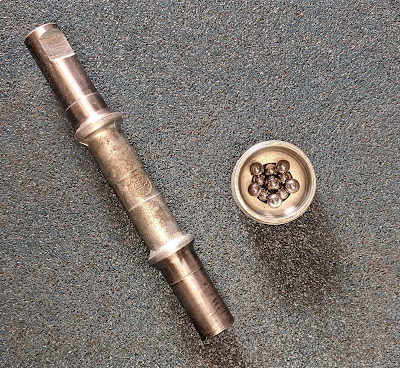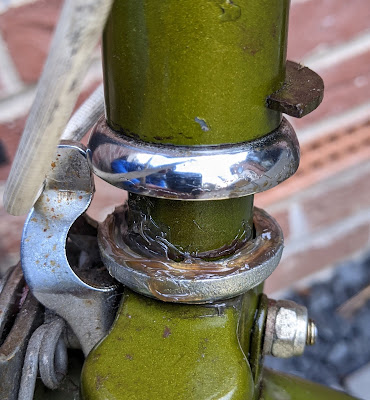As you work on a Twenty, you start to get a feel of the engineering. I find it useful to categorise: some parts are really well thought out and function well, others are merely adequate for their job and there's another category of redundant, useless, or poorly designed stuff. Then layered over that, some parts have elegance, possibly even beauty, while others are downright ugly. Add yet a further layer, namely weight, and a recipe emerges as to how to go about deciding what to keep and what to change.
Take the pedals. In the photo below (starting top left and going anti-clockwise): originals off a BSA 20, modern MTB style polymer flatties (BBB brand) and a generic polymer trap-type pedal:
Both the modern pedals have reflectors, today a legal requirement for safety, whereas the R20 pedals do not. Now, this R20 pedal has a certain elegance, it's true, but it's also narrow. Uncomfortable over a length of time, especially in soft soled shoes, as your feet curl over it. The weights add another factor:
| Pedal type |
g per pair |
| R20 |
651 |
| MTB Flatties |
336 |
| Polymer Cage |
286 |
I think it's remarkable that the old R20 pedals weigh so much, nearly 1.5lb! I discarded the polymer cage, for two reasons: the bearings on one were notchy and I didn't like the style for this bike. I thought it would be funky to have the MTB flatties. Apart from the beautiful wide platform they provide, the reflectors for safety and the weight saving (a stonking 315g), they are also shorter (12.1 cm v 11.0 cm from crank to pedal tip) and thinner, both of which reduce the chance of a pedal touching the road in a corner. So, my choice is made to switch to the MTB Flatties.
That all sounds great, but then I tried fitting the MTB Flatties and to my surprise while the diameters were comparable (9/16"), the threading was different! I wondered whether the cranks had some old English threading, but that seems like an odd explanation, because I've managed to get modern pedals on a R20 before and know that others have too. More likely, perhaps the threading tooling that Raleigh used was slightly different to modern standard. It could be just some R20s that were like this. I tried a few pedals and I found that most of them were too tight, but one or two modern pedals went in ok, but only on one crank. Whatever the reason, after playing about a bit with modern pedals, I now feel that for this project, I will stick with the original pedals. They are a basic, but serviceable design. The end cap prises off carefully with a thin screwdriver. Underneath, two spring clips and a washer to remove:

There are no BBs just a plain bearing. The axle at the top simply slides into what looks like a tapered sleeve in the pedal, then the washer with flats is added and the two spring clips to hold it all down. This one was gummed up and a quick clean and regrease worked wonders. They spin super smoothly now. At least they are hardly worn and have plenty of service to give. They'll clean up ok and add to the retro look.
Now consider the light bracket:
What an ugly lump that is, and given modern lights, it's redundant too. It serves a purpose in the headset, that is to increase stack height by a few mm in order to prevent the top lock nut from bottoming out. But that function can be easily achieved with a small standard spacer. How much does this monstrosity weigh? 77g! That's about the weight of SEVEN AAA batteries! Wowsers. Guess where that's going? Yes, in the recycling bin. NB, you have to remove the front brake caliper to get the stem out in order to lift this off the headset (see my post a few days ago on that wire loop thingy that restricts the movement of the stem vertically).
Note that by just by changing pedals and ditching the light bracket, you could save nearly 400g. Astonishing.
You can repeat this thought process for every other item on the R20, using the factors I suggested at the top of this post (I'm not considering maintenance items, such as brake pads, tyres, BBs, chain and cables):
Sturmey Archer hubs (both the front one and the rear epicyclic AW gear unit):
Elegant, well thought out, very functional, design kudos, unique, a bit heavy, but worth it! Pretty when clean and polished! I would keep these in nearly every case, unless there was a radically different vision for a particular build.
Chainset:
They are not all the same. Some patterns are indeed beautiful, others look more functional, but they have some eye appeal, I like the stamped "Nottingham Knight". They function well if you can deal with cotter pins and can live with the heavy chromed steel.
Bottom bracket:
It's perfectly functional, and isn't heavy, so in my view, this comes down to condition, and how important it is for you to change the chainset/eliminate cotter pins. The axle is a solid thing, and very rarely needs replacement. So, a good service with new BBs is usually all that's needed if you stick with cottered cranks. However, if you want to open up the world of square taper chainsets, then I believe that the simplest and best option is to find a square taper axle that fits and retain the same bottom bracket cups and 1/4" BBs. If that's not possible, then face the shell to 73mm or even 68mm (the width of my BSA 20 shell is 77mm as best as I could measure it), and rethread to standard 24 tpi. Some say that you should fill the threads with with a suitable molten metal before re-threading, but I've also read that many people have had success just rethreading directly, but slightly deeper than the original threads. Clearly a specialist's job. Failing any of those, then a problem solver may be a new threadless (friction fitting) unit.
Saddle:
Really ugly, uncomfortable for me, and enormously heavy! It's gotta go.
Seatpost:
Ugly, too short for many people, and very heavy, especially being steel with the steel clamp. Easy swap out to a modern one 28.6 usually. It's gotta go.
Chrome steel Handlebars and Stem
Function ok, and have a certain elegance. However, they are really rather heavy and often this is were customisation and your personal vision take over. A quill stem, with alloy riser bars, or bullhorns, etc.
Hand grips:
Yeuk! Hard ugly plastic and short. The only positive thing I can say about them is that they are hard wearing. But, I really think they have to go in just about any project (save for a restoration to original spec).
Chrome steel rims:
Work ok, but do not brake as well as alloys, especially in the wet. Look nice when clean and polished up. Heavy! My front wheel without nuts, rim tapes, or tyres weighs 940g. With rim tapes, tyres and nuts it weighs 1547g. Go or stay? It's really one of preference and also considering the condition of the steel rims that you have, the hassle of doing a rim swap, or finding/building another wheel that fits and also brakes that work with them. On the other hand, if you're not accelerating and braking a lot then, a heavy wheel provides a nice flywheel effect for steady riding - which is what I tend to do on a Twenty.
Nylon bushing top part of the headset:
Functions just about adequately, especially if you get a chance to clean it and lube the surface that touches the steerer, and adjust the headset properly. Once the light bracket is off, there's not much in the weight. So this one is a matter of preference again. This photo is of my current project, rust cleaned off and polished. I've kept the Nylon bushing, but ditched the light bracket (hence the black spacer):
Another approach is to remove the Nylon bushing and install the top half of a 1" threadless headset. When I do that again in the future, I'll be sure to take enough photos and post them on this blog.
Frame:
It wouldn't be a Twenty without one! It's a classic, has got to stay.
Forks:
They are designed to fit the cone flanges of the Raleigh Sturmey Archer front hub and they work well enough. A bit heavy. I think this one is mainly down to whether you keep that front hub or not. Also whether you want to do something funky, like BMX forks for 451 or 406 wheels or suspension forks. In which case, you can also change the whole headset.
Paintwork:
What condition is it in, and do you like it? Will it clean up nicely (after a wash, T-Cut and car polish)? Simple as that.
Clamps and Locking levers on steerer and seat tube:
These function adequately if well-maintained and positioned properly (evenly over their respective tubing slots). They add a bit of weight, but also provide easy quick adjustment. Also, if you are fitting a quill stem, the front clamp becomes unnecessary and can go (or stay!). So it's really up to you.
Brake caliper units:
Can function adequately if you take the time to set them up well, and they polish up ok too. Remove rust with WD40 and 0000 steel wool, chrome polish, lubricate and fix and adjust them properly. Use fresh cables. In many instances, I've changed only the inner wires, as the outer cables were fine. If the ends of the outer cables are kinked, you can snip off 5-10mm cleanly and that will improve the performance quite a bit. Modern alloy units would be an improvement and weigh less, but I think this one is really a matter of preference. Here's a front caliper, with rust cleaned off one arm, but not yet the other one:
Brake levers:
In my view they function adequately, and being steel are better than plastic levers! But there are lighter and better modern alternatives. So, it's a matter of preference for your particular build I think.
Mudguards (Fenders):
Functional, but do not have the break-off arms for safety as modern ones do and are relatively heavy. Must mount them properly and securely, or those beefy mounting arms could foul a wheel and cause a bad accident. I'm powder coating mine on this build.
Chainguard:
Serves a function (keeping your trouser leg clean!) and has a certain appearance. Don't weigh a great deal, but grams are grams. It's up to you! I'm powder coating mine on this build.
As I've said before, the Raleigh Twenty is like a blank canvas to a bike builder! The Raleigh bronze green BSA 20 that I'm working on at the moment is going to retain most of its original components, but with modern contact points (pedals, saddle/seatpost and hand grips). The next one may be a light weight with funky bars and alloy rims, but I haven't clearly figured out my direction on that one at this time.
Go with your heart and desire, enjoy the process, and all will be ok. Be creative, be artistic!






















































